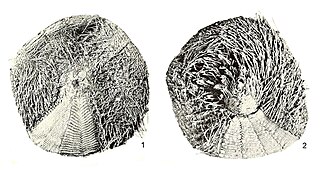Fire urchin may refer to one of several sea urchins including:
Fire urchin may refer to one of several sea urchins including:
Urchin or urcheon is the Middle English term for "hedgehog". It may refer to:

The subclass Euechinoidea includes almost all living species of sea urchin, and fossil forms going back as far as the Triassic.
Test(s), testing, or TEST may refer to:

Astropyga radiata, the red urchin, fire urchin, false fire urchin or blue-spotted urchin, is a species of sea urchin in the family Diadematidae. It is a large species with long spines and is found in the tropical Indo-Pacific region. It was first described in 1778 by the German naturalist Nathaniel Gottfried Leske.
Slate pencil urchin is a common name for several sea urchin species with blunt spines:

The Echinothurioida are an order of sea urchins in the class Echinoidea. Echinothurioids are distinguished from other sea urchins by the combination of a flexible test and hollow spines. The membrane around the mouth contains only simple plates, in contrast to the more complex mouth parts of their close relatives, the Diadematoida. They are nearly all deepsea dwellers.

Asthenosoma marisrubri aka Red Sea fire urchin and toxic leather sea urchin , is a relatively common sea urchin with a widespread distribution in the Indo-Pacific, and was till 1998 considered a color variant of Asthenosoma varium. Sea urchins are close relatives of starfish, crinoids, brittle stars and sea cucumbers, all being echinoderms.

Zebrida is a small genus of distinctive striped crabs, known as zebra crabs, that live in association with sea urchins in the Indo-Pacific.

Asthenosoma varium is a sea urchin. Growing up to 22 cm (8.7 in) in diameter, it lives on sand and rubble sea bottoms in the Indo-Pacific, from the Red Sea to Australia and Southern Japan. Its venom tipped spines, with distinctive globular swellings below the tip, can inflict a painful sting if handled; the pain lasts as long as several hours. This capacity, perhaps coupled with its reddish-brown color, has given it the common name Fire Urchin.
Several species of sea urchin share the name green sea urchin:
A sea urchin is a spiny marine echinoderm.

Asterechinus elegans is a species of sea urchin of the family Trigonocidaridae. Their armour is covered with spines. It is placed in the genus Asterechinus and lives in the sea. Asterechinus elegans was first scientifically described in 1942 by Ole Theodor Jensen Mortensen.
Asthenosoma dilatatum is a species of sea urchin of the family Echinothuriidae. Their armour is covered with spines. It is placed in the genus Asthenosoma and lives in the sea. Asthenosoma dilatatum was first scientifically described in 1934 by Ole Theodor Jensen Mortensen.

Asthenosoma ijimai is a species of sea urchin of the family Echinothuriidae. Their armour is covered with spines. It is placed in the genus Asthenosoma and lives in the sea. Asthenosoma ijimai was first scientifically described in 1897 by Yoshiwara.

Asthenosoma intermedium is a species of sea urchin of the family Echinothuriidae. Their armour is covered with spines. It is placed in the genus Asthenosoma and lives in the sea. Asthenosoma intermedium was first scientifically described in 1938 by Hubert Lyman Clark.
Asthenosoma marisrubis is a species of sea urchin of the family Echinothuriidae. Their armour is covered with spines. It is placed in the genus Asthenosoma and lives in the sea. Asthenosoma marisrubis was first scientifically described in 1998 by Weinberg & de Ridder.
Asthenosoma periculosum is a species of sea urchin of the family Echinothuriidae. Their armour is covered with spines. It is placed in the genus Asthenosoma and lives in the sea. Asthenosoma periculosum was first scientifically described in 1964 by Endean.
Allopontonia brockii is a small commensal shrimp in the family Palaemonidae.

The Echinothuriidae are a family of sea urchins in the order Echinothurioida. Due to their soft skeletons, most are called "leather urchins", but species in the genus Asthenosoma are also known as "fire urchins" due to their bright colors and painful, venomous sting.

Asthenosoma is a genus of sea urchins in the family Echinothuriidae. Their spines are covered with harmful venom capsules.